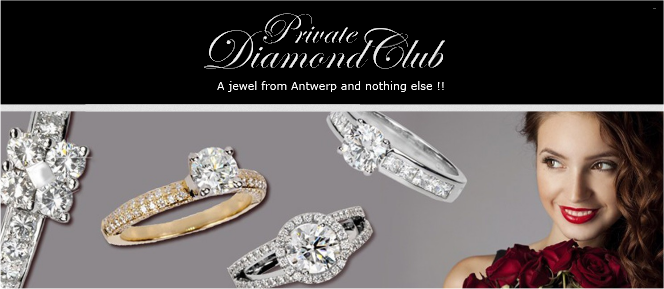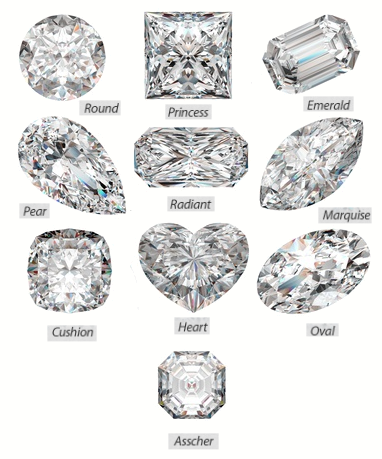Fashion
Know Your Diamonds: All about the shape
Diamonds will always be a source of intrigue ... This month we take a look at some of the shapes available when choosing diamonds and speak with the experts at the Private Diamond Club...
Yvan Delcourt, investment diamond expert and founder of the Private Diamond Club tells us that the most common shape of diamond is the round one or "brilliant cut". With 57 facets it is the form that returns the most light and is the best selling and most expensive.
There are other shapes, known as "fantasy" that are used in jewellery. We feature 10 shapes, the princess cut, emerald, pear, radiant, marquise, cushion, heart, oval and asscher.
Round Brilliant: Developed around 1900, the round diamond is the most popular cut given to diamond. It is usually the best choice in terms of saleability, insurability (due to its relatively "safe" shape), and desired optics.
Princess Cut: The princess cut is the second most popular cut shape for diamonds, next to a round brilliant.[citation needed] The face-up shape of the princess cut is square or rectangular and the profile or side-on shape is similar to that of an inverted pyramid with four beveled sides. The princess cut is a relatively new diamond cut, having been created in the 1960s.
Emerald: Stones whose outlines are either square or rectangular and whose facets are rectilinear and arranged parallel to the girdle are known as step- or trap-cut stones. These stones often have their corners truncated, creating an emerald cut with an octagonal outline. This is done because sharp corners are points of weakness where a diamond may cleave or fracture. Instead of a culet, step-cut stones have a keel running the length of the pavilion terminus. Like other fancy shaped diamonds, emerald cut diamonds can come in a variety of length to width ratios. The most popular and classic outline of emerald cut diamonds are close a value of 1.5.
Pear (or teardrop cut): The first pear-shaped diamond was created in the 1400s by Flemish cutter Lodewyk van Berquem of Bruges, inventor of the diamond-polishing wheel, or scaif. This invention enabled him to polish all the facets of the diamond to optimize light reflection within it. It was from this watershed moment onwards that diamonds began to be used in jewellery.
Radiant: This very special cut is the result of one man’s dream to combine the elegance of an Emerald Cut with the unparalleled brilliance of a Round Brilliant Cut. The Radiant Cut diamond allows people to choose a square or rectangular cut without compromising on brilliance. Recently, the shape has also gained popularity as a preferred choice for engagement rings. Usually these diamonds are set as a solitaire, but they also look amazing when set with either baguette or round shoulder stones.
Marquise: The name is derived from the Marquise of Pompadour, for whom King Louis XIV of France allegedly had a stone fashioned to resemble what he considered her perfectly shaped mouth. Because marquise diamonds are long and narrow, they can also create the illusion of greater size. Owing to the shape this cut is sometimes known as a “Navette” (little boat).
Cushion: The cushion cut diamond once referred to as old mine cut) combines a square cut with rounded corners, much like a pillow (hence the name). ... While generally less brilliant than round brilliant diamonds, cushion cut diamonds often have better fire, which is part of their appeal. This classic cut has been in existence for almost 200 years, and for the first century it was the most popular diamond shape, similar to round cut today.
Heart Brilliant: Heart shaped diamonds are very popular in solitaire pendants as well as rings and are of course, the unique and unmistakable symbol of love. When choosing a heart, symmetry is a very important characteristic, since it is critical that the two halves of the heart are identical. The first recorded heart shape diamond appears in a portrait entitled "The Gonzaga Princess,” painted around 1605 by Frans Pourbus the younger.
Oval: The diamond oval cut is a newer type of cut created in the 1960s by the popular diamond company Lazare Kaplan International. The cut is a modified brilliant cut which preserves many of the supreme qualities of the original - and exceptionally flashy - round brilliant cut. Most oval cuts contain 56 facets, but some may have a few more facets depending on how the underside of the stone (known as the pavilion) is cut.
Asscher: In 1902 Joseph Asscher designed the original Asscher cut. This emblematic cut was the first signature cut to be patented. The Asscher Diamond Company held its exclusive patent until the Second World War and saw strong sales internationally. This cut’s popularity peaked in the late 1920s but remained a somewhat rare commodity for the remainder of the century, available only in antique shops and specialised Art Deco jewellers. At the onset of the new millennium, following considerable research and development, the Asscher cut was redesigned with new specifications and additional facets for a more brilliant shine, and has since regained its popularity.

Whatever your preference for the style of diamond is, you can always speak with the Private Diamond Club who will be happy to help and advice. The Private Diamond Club always issue a certificate with every purchase which is the best way to guarantee the authenticity and quality of the diamond.

Buying direct through the Private Diamond Club of Antwerp
you could save up to save 50%.
Contact them for further details: contact@private-diamond-club.com
Enjoy visiting the Private Diamond Club website and browse through
their online catalogue:






